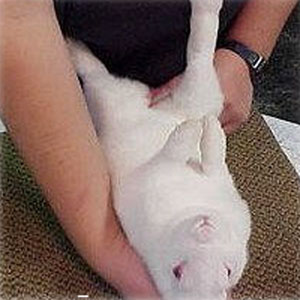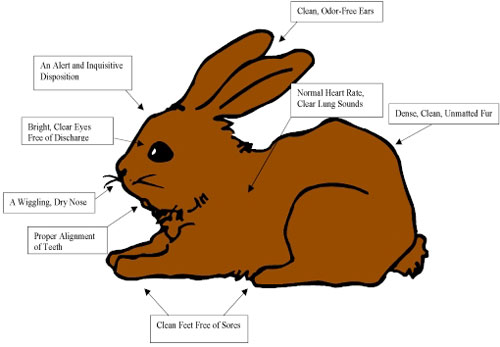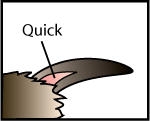Backyard Rabbit Keeping, Part 9/15 – Health
 I hope you will not need to consult this section very often. If your rabbits are healthy outdoor types with warm, dry hutches, it is not likely that you will. Wild rabbits are usually healthy, in the absence of something like myxomatosis, as long as their numbers are kept to a reasonable level. Over-population tends to breed disease, due to overcrowding and competition for food. Backyard rabbits should likewise be healthy. They have none of the fight for survival of the wild rabbit; they will have plenty of room and exercise, a warm dry bed, and a variety of fresh natural foods. And also, they will not be suffering from the stress associated with commercial rabbit keeping. Wire cages, artificial daylight, continuous breeding and pelleted food are no doubt essential to profit from large numbers of rabbits, but they are also bound to cause stress. Your rabbits will avoid this, which is the great advantage of the backyard system.
I hope you will not need to consult this section very often. If your rabbits are healthy outdoor types with warm, dry hutches, it is not likely that you will. Wild rabbits are usually healthy, in the absence of something like myxomatosis, as long as their numbers are kept to a reasonable level. Over-population tends to breed disease, due to overcrowding and competition for food. Backyard rabbits should likewise be healthy. They have none of the fight for survival of the wild rabbit; they will have plenty of room and exercise, a warm dry bed, and a variety of fresh natural foods. And also, they will not be suffering from the stress associated with commercial rabbit keeping. Wire cages, artificial daylight, continuous breeding and pelleted food are no doubt essential to profit from large numbers of rabbits, but they are also bound to cause stress. Your rabbits will avoid this, which is the great advantage of the backyard system.
Looking through my collection of rabbit books, I find that the section dealing with rabbit diseases has got larger over the years. During the war, rabbits were not expected to ail much. They were needed for the war effort. (My mother asserts that people didn’t ail much at that time, either there must be a moral somewhere.) Intensification in the rabbit industry and new methods have brought problems; if you possess thousands of rabbits you are obviously going to panic at the least sign of an outbreak of anything catching, hence the blanket antibiotic treatment.
All the same, you may be unlucky enough to get some trouble occurring with your backyard rabbits. It is very good policy to get to know your vet, and to be on good terms with him. Vets are never too busy to advise people who are really interested in their animals, however small the animal or the enterprise. Listen intelligently and glean knowledge. Vets are usually happy to explain what they are doing, and why.
Let us consider a healthy rabbit. Its eyes are bright, its coat glossy and smooth. The ears are warm, neither hot nor cold. The droppings are firm but moist, an important point to watch. If the rabbit is scoured or constipated, something about your management is wrong. The first job is. to put it right.
This is the whole foundation of keeping healthy animals. Study them every time you go to see them; subconsciously you will be checking the signs of health. By watching them you will get to know how they behave when they are well and happy and minding their own business. This is normal behavior; any departure from it means a danger signal. The more you study the stock, the earlier the signal will reach you — and this means the difference between failure and success very often in treating ailments.

When anything goes wrong, the tendency now is to treat with antibiotics to suppress a specific organism. Sometimes you may have to do this, but to my mind it can be the wrong approach.
Why did that organism manage to get a hold? For example, the bugs which cause coccidiosis are often present in healthy rabbits; something goes wrong and they see their chance and attack. The point to watch is what has gone wrong with your management. Put that right, and you will have solved the problem.
Commercial rabbit keepers, understandably nervous, are more inclined to kill the off-color rabbit and so remove the potential source of infection than to try to cure it. No doubt you will rather try to cure a sick animal; you will be prepared to spend a little time trying to find a cure, although let us hope your cases are few. The cure will not necessarily be ex-pensive, because some of the best treatments are free for the gathering. But they take time and patience, as do many of the wise old recipes.
Scouring:
This is probably the most common reason for rabbit losses, especially among pet rabbits. Bad diarrhea can soon kill a rabbit; and they scour easily. Avoid overfeeding; this is the main cause where children are involved. They kill their pets with kindness quite often. Frosted greens in winter can cause stomach troubles. See that the frost has melted from any green food before the rabbit gets hold of it. Fermenting food in any form is equally bad, so beware of heated grass cuttings. Remember that, unlike the dog, the rabbit cannot be sick and get rid of unsuitable food that way.
When your rabbits scour, find the cause. Hold an inquest in the family if necessary; it is vitally important to find out what has happened.
At the same time, treat the rabbits immediately. Give them no food but hay and water, and plenty of dry bedding. Give a handful of blackberry leaves if you can find some -these are an old country remedy for scour. Or feed a little Shepherd’s Purse, rabbit keepers used to hang up bunches of this plant to dry in their sheds, so as to have a supply handy when needed. This sort of treatment is safe and slow. It will not act quickly like the wonder drugs, but persevere and you should succeed. Other astringent or binding plants include burnet, plantain, cleavers – you will gain experience of what works best and where to find it.
It will of course help the cure if you have discovered the source of the trouble and removed it. If the scours are persistent one remedy you might try is slippery elm powder, usually obtainable from health food shops. Parsnips are soothing in action and might be good when the rabbit is recovering. It is common sense to choose the right foods and avoid laxative and strong herbs for a while; unless you think an infection is involved, in which case a mild laxative is a good idea to begin with in order to clean out the system.
Constipation:
This is less likely with rabbits but it can happen in winter when green food is scarce. Once again, find the cause. Dandelion, groundsel and fresh young grass are good laxatives. Castor oil is the dose when something stronger is needed. The amount is one teaspoonful for an adult rabbit, half for young ones.
Parasites:
Rabbits are not particularly prone to parasites, but some do occur and it is possible that you could buy in stock that was infested, or your rabbits could pick up something from a neighbors cat or dog.
Tapeworms are rare, but they can happen. There are two types of roundworm, but they do not often give trouble. If you suspect worms symptoms will be thin, unthrifty rabbits even on good food – feed plenty of garlic. The wild garlic that grows in woods (“ransoms”) is popular with wild rabbits.
Fleas are more common, but they are not always found on rabbits. They usually live in the ear; besides being an irritant, they can be dangerous because they migrate from dead to healthy rabbits in the wild and carry the virus of myxomatosis. Domestic rabbits don’t often catch this disease, but it can happen when it is rife in the wild population. A dusting with insect powder should get rid of fleas. Lice are less usual; the old-fashioned remedy is a little sump oil.
Canker of the ear is an unpleasant thing sometimes seen in rabbits. It is a brown scab, accompanied by swelling and inflammation. It is caused by a mite. Look for it if your rabbits scratch their ears a lot, or shake their heads, or carry their head to one side. The chemical treatment for canker is benzyl benzoate, given at about five-day intervals. Or there is a proprietary brand of canker treatment called Otodex. If you prefer herbal treatments, apply neat witch hazel extract, with cotton wool. During the war they used to soak afflicted ears with sump oil. To finish off, they dusted with flowers of sulphur. Whichever treatment you use, try to soften the deposit in the ear and then the next day gently remove it. Keep on treating until you are sure it has all disappeared, the mites can be very persistent. Canker is contagious, so it would be well to clean and disinfect the hutch if you do have a case.
Sores:
Once again, find the cause if your rabbits have sores. If there are several rabbits living together it could be the result of fighting. The most common place for sores is on the hocks, due to wet or unsatisfactory bedding or floors. Change to a softer bedding and clean out the cages more often if you see sore hocks; sometimes wire cages will cause this. Apply soothing ointment – although they tend to lick it off again. Antiseptic plants such as white clover should be included in the feed.
Sneezing and Colds:
Are the living conditions wrong? Dusty hay can bring on sneezes, for the rabbits and you as well. Cold damp weather may have the same effect. Respiratory diseases are a bugbear in indoor rabbitries, but your out-side rabbits should be able to breathe freely. Garlic and onions should be good treatments, as for human colds. I mentioned snuffles when talking about buying rabbits. It would be a pity to buy in pneumonia or the dreadful rhinitis, but this is unlikely if you deal with a reputable breeder. The more serious or persistent snuffles will need vet advice, but do try to find the cause if you can. Violent changes in the weather may affect the rabbits sometimes.
Coccidiosis:
This is a problem in commercial rabbitries, where it can quickly spread. There are two types, intestinal and hepatic, which means affecting the liver.
Intestinal coccidiosis: Elmeria performa and Eimeria magna are the organisms responsible. In some circumstances they will attack the intestines of the rabbit, but they often live in the gut without doing any damage. Nobody seems to know exactly why; but it is suspected that a rabbit under stress is more likely to be attacked. The disease is spread in droppings and dirty bedding. If your rabbits suddenly stop growing, suspect this. It is difficult to describe specific symptoms; scour isn’t one of them, but it may well occur during an attack because other bugs will creep in to take advantage of an unwell rabbit. Sometimes the attack is fatal, sometimes not; but they don’t do well after it.
In the Liver: In this case the organism responsible is different , Elmeria steidae. With this kind the rabbit usually dies before you know that anything is wrong. If you open it up, you will find white spots in the bile ducts of the liver. Large producers usually do a postmortem on a dead rabbit. If you study the bodies of healthy ones you will get to know what to look for.
If you are alarmed by an outbreak of something like this the vet is the best person to advise you; he will probably prescribe antibiotics. Herbalists give garlic for coccidiosis, but first of all they give a laxative to clear out the intestines. The hutches should be thoroughly cleaned to get rid of the infection. If you want to fumigate, burn cayenne pepper. This will purify the place without leaving residues of poison for the animals to pick up later.
Enteritis:
This is a similar disease in that the organisms are often present in a normal rabbit. When an attack occurs, the intestines are inflamed, but backyard rabbits shouldn’t be troubled with it very often unless their diet becomes unsuitable for some reason. Animals on ‘high-pressure’ fast growth diets are more prone to this disease. Rabbits keepers who use pellets tell me that the composition of the pellets they buy seems to vary from batch to batch, and the sudden change from one sort to another will occasionally set up irritation in the intestines. Think of it as an internal irritation, and if your rabbits get it, find the cause. Dry bread with a little milk and hay is the usual backyarders treatment; follow this with a soothing, healing herb such as comfrey if you can find one.
Dystokia:
This is the proper name for difficult kindling, which again is not very usual, but perhaps I ought to mention it. It is obvious that if a doe shows all the signs of being about to produce a litter and nothing happens, she will need help and you should call the vet. But don’t panic too soon. Sometimes she will be restless, start to make a nest and so on quite a time before she produces the young ones; so give her time to do this and don’t breathe down her neck too heavily. On the other hand, if you see her actually strain with no resuit, get help. A dead baby or a very big one can cause an obstruction in rare cases, but in general the rabbit has less problems than other animals in giving birth.
Claw Clipping:
| This is necessary when the rabbits are confined and cannot use their claws as they would normally do, to keep them worn down. When they get too long, clip the claws with strong nail clippers or pliers. There are side-cutting pliers for this kind of job. You have to hold the nail clear of the fur and take care that it is not cut too short. Avoid the quick, the red center of the claw. Done properly, it should be as painless as nail cutting is for us. |  |
- Why Why Keep Rabbits?
- Rabbits Past and Present
- Some Basic Information
- Making a Start
- Housing
- Feeding
- Growing Crops for Rabbits
- Breeding
- Health
- Harvesting the Wild Rabbits
- The Harvest
- Using Rabbit Meat
- Fur Production
- Showing
- Angoras
Further Research:
   |